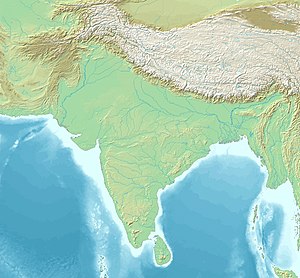
Back Indiese subkontinent Afrikaans Indischer Subkontinent ALS شبه القارة الهندية Arabic شبه القاره الهنديه ARZ ভাৰতীয় উপমহাদেশ Assamese Socontinente indiu AST भारतीय उपमहाद्वीप AWA Hindistan yarımqitəsi Azerbaijani Һинд субконтиненты Bashkir Subkontinenteng Indio BCL
 Geopolitical coverage of the subcontinent | |
| Area | 4,440,000 km2 (1,710,000 sq mi) |
|---|---|
| Population | c. 1.9 billion |
| Countries | |
| Dependencies | External (1)
|
| Languages | |
| Time zones | List:
|
| Largest cities | |
The Indian subcontinent is a geological term describing the landmass known as the Indian Plate, which drifted northeastward from the ancient supercontinent Gondwana and collided with the Eurasian Plate around 55 million years ago.[1][2] The boundary of the continental collision between these plates, called the Chaman Fault, traverses modern-day Pakistan and Afghanistan. The Indian subcontinent is typically defined to include the countries of Bangladesh, Bhutan, India,[note 1] Maldives,[note 2] Nepal,[note 3] and Sri Lanka,[note 2] as well as Pakistan.[3][4][5][6] However, only part of Pakistan, mainly the southeastern region, lies on the Indian Plate, with the remainder situated on the Eurasian Plate.
Although the terms "Indian subcontinent" and "South Asia" are often used interchangeably to denote the region,[7] the geopolitical term of South Asia also includes Afghanistan, which is typically not considered a part of the Indian subcontinent.[8]
The Indian subcontinent is one of the most populated regions in the world, holding roughly 20–25 percent of the global population. Geographically, the peninsular region in Southern Asia is located below the Third Pole, delineated by the Himalayas in the north, the Hindu Kush in the west, and the Indo-Burman Ranges in the east.[9] The neighboring geographical regions around the subcontinent include the Tibetan Plateau to the north, the Indochinese Peninsula to the east, the Iranian Plateau to the west, and the Indian Ocean to the south.
Apart from Maritime Southeast Asia (the Malay Archipelago), the maritime region of the subcontinent (littoral South Asia) is the only subregion of Asia that lies partly within the Southern Hemisphere: the British Indian Ocean Territory[citation needed] two of the 26 atolls of the Maldives lie entirely within the Southern Hemisphere.
Cite error: There are <ref group=note> tags on this page, but the references will not show without a {{reflist|group=note}} template (see the help page).
- ^ Halliday, Thomas J. D.; Holroyd, Patricia A.; Gheerbrant, Emmanuel; Prasad, Guntupalli V. R.; Scanferla, Agustín; Beck, Robin M. D.; Krause, David W.; Goswami, Anjali (2020), Prasad, Guntupalli V.R.; Patnaik, Rajeev (eds.), "Leaving Gondwana: The Changing Position of the Indian Subcontinent in the Global Faunal Network", Biological Consequences of Plate Tectonics: New Perspectives on Post-Gondwana Break-up–A Tribute to Ashok Sahni, Cham: Springer International Publishing, pp. 227–249, doi:10.1007/978-3-030-49753-8_9, ISBN 978-3-030-49753-8, retrieved 22 January 2025
- ^ Robert Wynn Jones (2011). Applications of Palaeontology: Techniques and Case Studies. Cambridge University Press. pp. 267–271. ISBN 978-1-139-49920-0.
- ^ "Indian subcontinent". New Oxford Dictionary of English (ISBN 0-19-860441-6) New York: Oxford University Press, 2001; p. 929: "the part of Asia south of the Himalayas which forms a peninsula extending into the Indian Ocean, between the Arabian Sea and the Bay of Bengal. Historically forming the whole territory of Greater India, the region is now divided into three countries named Bangladesh, India and Pakistan."
- ^ Cite error: The named reference
dkumar889was invoked but never defined (see the help page). - ^ Cite error: The named reference
pirbhai14was invoked but never defined (see the help page). - ^ Cite error: The named reference
mmannwas invoked but never defined (see the help page). - ^ Cite error: The named reference
McLeod p1was invoked but never defined (see the help page). - ^ Jim Norwine & Alfonso González, The Third World: states of mind and being, pages 209, Taylor & Francis, 1988, ISBN 0-04-910121-8 Quote: ""The term "South Asia" also signifies the Indian Subcontinent""
Raj S. Bhopal, Ethnicity, race, and health in multicultural societies, pages 33, Oxford University Press, 2007, ISBN 0-19-856817-7; Quote: "The term South Asian refers to populations originating from the Indian subcontinent, effectively India, Pakistan, Bangladesh and Sri Lanka;
Lucian W. Pye & Mary W. Pye, Asian Power and Politics, pages 133, Harvard University Press, 1985, ISBN 0-674-04979-9 Quote: "The complex culture of the Indian subcontinent, or South Asia, presents a tradition comparable to Confucianism."
Mark Juergensmeyer, The Oxford handbook of global religions, pages 465, Oxford University Press US, 2006, ISBN 0-19-513798-1
Sugata Bose & Ayesha Jalal, Modern South Asia, page 3, Routledge, 2004, ISBN 0-415-30787-2 - ^ Cite error: The named reference
Chapman, Graham P. p. 10was invoked but never defined (see the help page).
